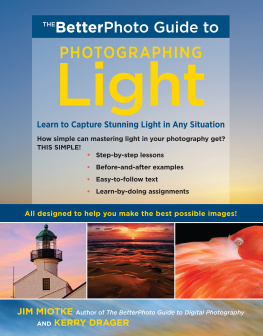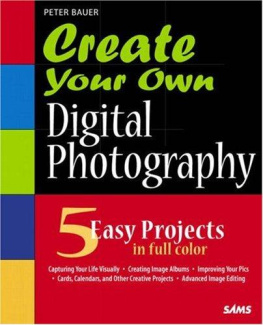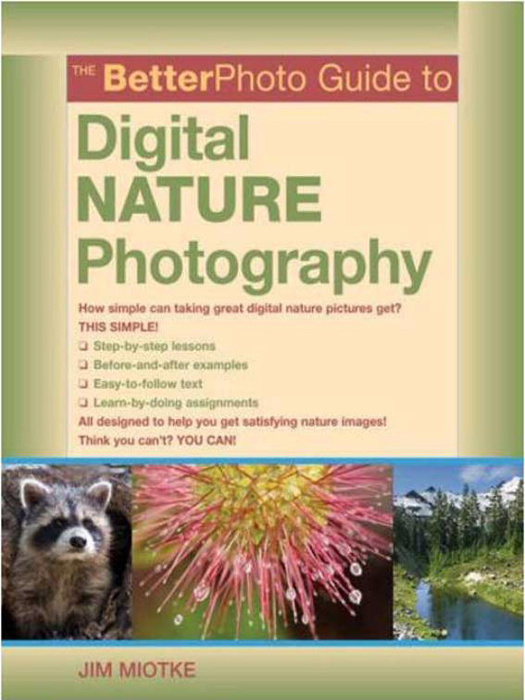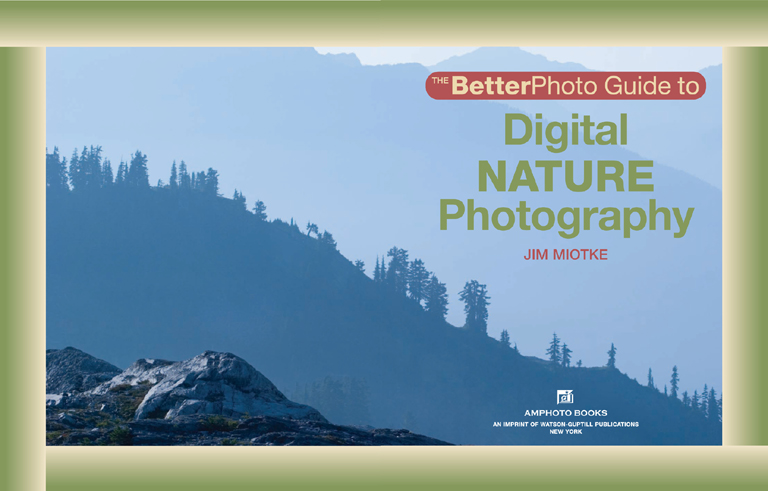
1/750 SEC. AT f/8, ISO 100, 28135MM LENS AT 100MM
Editorial Director: Victoria Craven
Senior Development Editor: Alisa Palazzo
Designer: Areta Buk/Thumb Print
All rights reserved. First published in 2007 by Amphoto Books an imprint of Watson-Guptill Publications, the Crown Publishing Group, a division of Random House, Inc., New York.
www.watsonguptill.com
www.amphotobooks.com
AMPHOTO BOOKS and the Amphoto Books logo are trademarks of Random House, Inc.
Copyright 2007 Jim Miotke
Cover photograph by Jim Miotke
Cover design by Areta Buk/Thumb Print
Drawings by Melody Hauf
Library of Congress Cataloging-in-Publication Data
Miotke, Jim.
The Betterphoto guide to digital nature photography / Jim Miotke.
p. cm.
Includes index.
eISBN: 978-0-8174-0026-2
1. Nature photography. 2. PhotographyDigital techniques. 3. Digital cameras. I. Title.
TR721.M56 2006
778.93dc22
2006014700
v3.1
Also Available as an eBook:
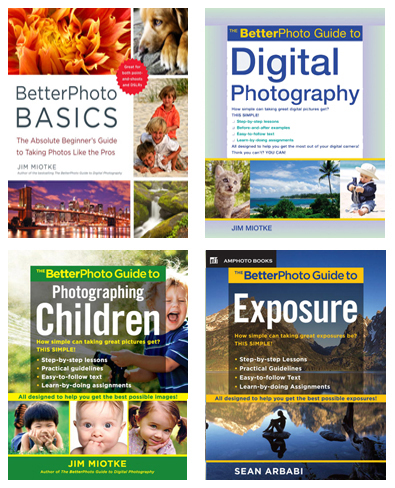
BetterPhoto Basics
The BetterPhoto Guide to Digital Photography
The BetterPhoto Guide to Exposure
The BetterPhoto Guide to Photographing Children

Acknowledgments

I am deeply grateful to many people who have helped me write this book. First and foremost, my wife, Denise, has always been my first editor, my business partner, and my best friend. Denise, I owe you big time!
I am also indebted to the team at AmphotoVictoria Craven, Alisa Palazzo, Areta Buk (at Thumb Print), and Lori Horakas well as the team at BetterPhotoHeather Young, Kerry Drager, Jay Wadley, Amy Wadley, Keri Malinowski, Maureen Whitmore, Karen Orr, Brian Hauf, and Tori Martinez. Whether you have been accompanying me on nature photography adventures; designing new home pages; setting up the office; handling sales, customer service, and product development; and so much more, I seriously could not have written this book without your help.
Thanks to Melody Hauf who has again provided her fun drawings, as well as to Marti Hauf and Maggi Foerster, who have again provided a great deal of prayerful support.
Thanks also to the following students who contributed a few images to this book: Terri Beloit, Rob Berkley, Deborah Lewinson, Bob Clayton, Karen Glenn, Cindy Hamilton, Melissa Heinemann, Alicia Lehman, Edgar Monzn, John Richlin, and Kelly Toshach.
In addition, I feel honored to know and work with such great photographers as Tony Sweet, Jim Zuckerman, Brenda Tharp, and Lewis Kemper, as well as every one of the amazing instructors at BetterPhoto. I would also like to thank Jack Warren, Art Wolfe, Jay and Kim Deist, John Baker, Kathy Konesky, Richard Buchbinder, Richard and Sylvia Turpin, Elvira Lavell, and Jana Jirak and the BetterPhoto members. In particular, I give my thanks to the one thousand of you who answered my survey and provided me with pages and pages of questions to answer in this text. And Julian, of course.

To the members of BetterPhoto and nature lovers everywhere
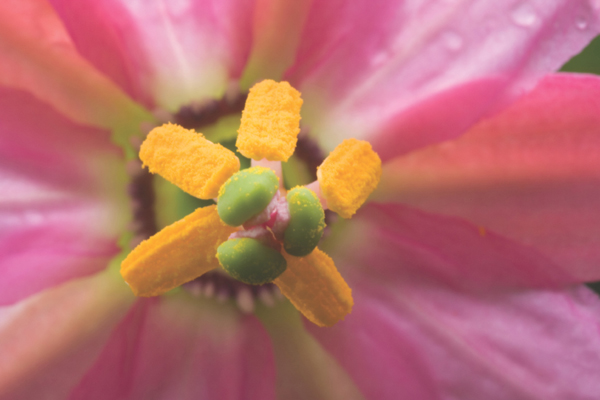
3.2 SECONDS AT f/32, ISO 160, 100MM MACRO LENS
Contents
CHAPTER 1
Light
CHAPTER 2
Composition
CHAPTER 3
Digital Exposure
CHAPTER 4
Landscapes
CHAPTER 5
Macro Photography
CHAPTER 6
Wildlife
Introduction
WOULD YOU LIKE to consistently make photos that stand out from the regular, tired snapshots? Youve come to the right place. In this book, I share with you the most time-tested, helpful tips that will give your photos that extra something special. Learn these simple techniques and you will immediately be able to create unique, uncommon, and amazing nature shotsconsistently!
When I first started writing this book, I invited BetterPhoto.com members to take part in a survey. I hoped to learn what confused photography enthusiasts the most and what people most wanted to learn with regard to digital nature photography. Within a few days, one thousand people responded to the survey! The need for help on this subject was evident, and the questions asked gave me an excellent idea of the direction I needed to take. Overwhelmingly, people cited three things as the top concepts they wanted help understanding: light, composition, and exposure (especially with a digital camera).
These BetterPhoto members knew that working with light is what photography is all about, but they didnt know how to get from point A to point B. And they deeply wished for a command of the technical (and often frustratingly confusing) concepts of exposure, aperture, shutter speed, and ISO. Plus, they wanted to learn more about arranging the objects in their images and about deciding which compositions best fit particular scenes and subjects.
Im sure that you feel the same way. Therefore, Ive structured my book around these topics and added two additionaland equally importantconcepts: rule breaking and learning through practical assignments. And, since many people wanted to learn about practical issues (such as planning, packing, equipment, and weather), youll find Practical Matters pointers throughout the book; these tips are all centered on the real-world stuff you need to know when you go out shooting.
My goal has been to write a book that helps everyone, not just the few who have the opportunity to spend months at a time in the high alpine meadows (i.e., professional photographers). This book is for people with other jobs, with families, with limited financial resources. Its intended to both show you how you can connect with the nature available to you and make the best photos with what you have and what you can afford.
L.C.D.
To help you remember what to keep in mind while youre out in the field, Ive come up with the acronym L.C.D., which stands for light, composition, digital exposure.
The order of the first three chapters follows this acronym, and then periodically throughout the rest of the book, I will address L.C.D. issues specific to a particular topic. So, for example, in the macro section, Ill mention any lighting, composition, and digital exposure issues and guidelines that relate to close-up photography.
ASSIGNMENTS AND TIPS
Reading about photography is great, but theres nothing like taking what you read out into the field and doing an assignment. Practicing what youve read will help you learn fast, and nothing is better than practicing immediately after you learn a new concept. The assignments will help you do this, and the tips that run throughout the book will provide quick helpful hints and techniques.


